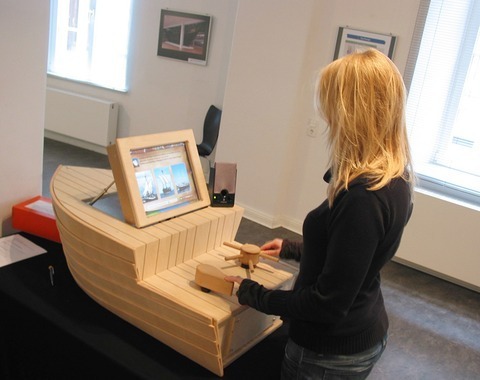
Picture taken from: http://www.nordsee-zeitung.de/region/Bremen_artikel,-Hanse-Historie-als-PC-Spiel-_arid,363551.html
Besides making our lives easier, tangible interfaces could also be used to teach new skills/ideas/concepts in a more effective manner. This was the case of the game Hanse 1380, which I was involved in. This kiosk-based educational game was developed as part of a master and research project carried out by the University of Applied Sciences Bremerhaven for the German Maritime Museum. The game was designed to entertain and educate young visitors about the museum’s main attraction: the medieval boat called Bremerkogge.
Among other learning objectives, we wanted to teach how the cog was sailed - mainly by utilizing the rudder for direction and capstan for grabbing the wind power. We found out that in order to make sailing more easily understandable, we would need to support the game with tangible controllers and make them resemble as much as possible the cog’s real parts. During our usability tests we realized that the kiosk controllers made a more straight symbolic connection with the representation of the cog in the game (and also with the cog replicas presented at the museum). Instead of pressing buttons on the keyboard to rotate the sail or move the rudder, the player could easily rotate and move the controllers on the kiosk to accomplish the same tasks.
The question regarding the use of tangible interfaces in my new project, which is also related to museums, is a bit different. The main goal of the system I plan to build is to support interpretation at the museum by translating some social media strategies to an on-site context, therefore utilizing interfaces that may go beyond screens, no matter whether they are tangible or not (UI vs. UX). Finding out possible translations and mixing objects’ affordances with GUI properties is in the scope of my project, although it’s not my main concern.
The core of the system is similar to the most popular social networks out there. Collecting, discussing, voting, rating etc. How it’ll be presented is still not clear, and I plan to apply design thinking strategies together with the staff of the museum that I’ll collaborate with in order to find this out.
What’s clear however is that “form follows content”! It doesn’t concern me much the use of physical objects, but instead how to optimize processes making them suitable to be used in public spaces taking into consideration what needs to be communicated. Whether or not tangible interfaces will be implemented, will depend on the necessity and concept. Nevertheless, I’d like definitely to avoid the use of screens as much as possible, since according my experience in previous projects, they consume a lot from visitors. As Krishna shows, sometimes “the best interface is no interface”.
They last thing I’d like to point out is that no matter which kind of interface you are using, you should always be honest with your public. As I see, the main problem with the AR-JAM presented on the article Beyond Affordance: Tangibles’ Hybrid Nature, by Eva Hornecker, was not that the technology used couldn’t keep up with the way kids were interacting with the system, but instead the lack of honesty about what the paddles were able to do. There was a lack of information on the system which should’ve been advised before use. Erratic behaviors surely create frustration.
There are many things technology cannot do, so then let’s be honest about them. Just take into consideration that people are able to play boardgames for centuries and they have lots of fun with them. For most of those games, there are even no physical constraints, but instead a set of rules that should be known and followed. Rules are a basic principle of any game and being honest about the rules of the system is something that can be applied for tangible interfaces as well, especially when the technology can’t keep up. This doesn’t necessarily makes the interaction less interesting.

No comments:
Post a Comment